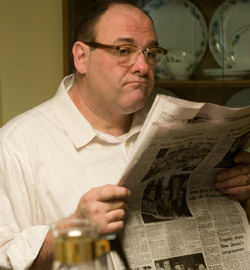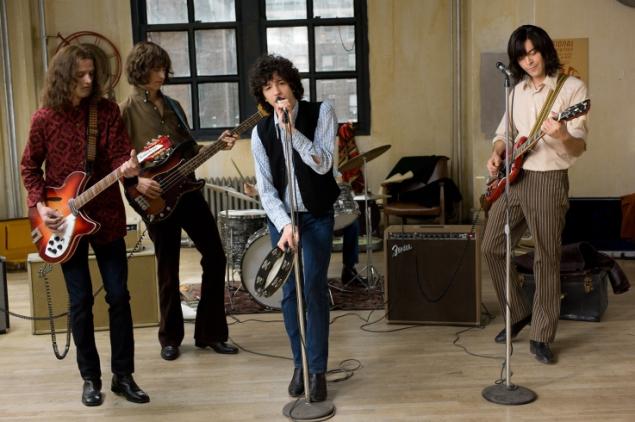Film Review: “Not Fade Away” — David Chase’s Magical Misery Tour
The Sopranos creator is the latest filmmaker to tackle the 1960s. He provides an antidote to the rose-tinted lenses of nostalgia, a grounded portrayal that evokes the truth of the period rather than the mythology.
Not Fade Away. Directed by David Chase. At cinemas around New England.
By Jonathan Hawley
The news that David Chase chose to focus his debut feature film on the exploits of an aspiring musician in 1960’s New Jersey triggered many raised eyebrows. It seemed like an unusual topic for the television revolutionary behind the landmark series The Sopranos. Why would Chase, the architect of what is not only one of TV’s most complex and memorable crime stories but also among the most perceptive chronicles of modern America’s decline, choose such a radically different subject, one that has already been examined by countless cultural theorists and artists (none more skillfully, as it happens, than Chase’s own protégé, Mad Men’s Matthew Weiner)?
Not Fade Away offers a powerful, if flawed, answer to the question. Chase’s true strength as a writer and director isn’t his talent with violence or crime but his skillful evocation of time and place. The Sopranos was always less concerned with the shady goings-on in Satriale’s butcher shop and the Bada Bing strip club than it was with the mean New Jersey streets outside. By drawing upon his own experiences (once again) of growing up in a dysfunctional, suburban, Italian-American family, Chase has created a steely rather than cheery meditation on the 1960s. The catch is that Chase ends up sticking too close to the disappointments of the ordinary — Not Fade Away is more of an intellectual exercise in disillusionment than a multi-dimensional study of the period.
Spanning the turbulent decade from the Kennedy Assassination on, Not Fade Away focuses on Doug (John Magaro), a young Italian-American growing up in a middle-class, New Jersey home. He is the classic Baby Boomer youth—rebelling against his parents and his heritage, growing out his hair, transformed by his discovery of The Beatles and the blues. Doug (like Chase, a drummer) joins with his high school friends Wells (Will Brill) and Eugene (Jack Huston, looking unrecognizably normal without his Boardwalk Empire facemask) to form a band and, in his pursuit of musical fame, drops out of college and becomes lost in a funk of drugs, ideals, and cynicism. His stern, blue-collar father (James Gandolfini) watches with growing consternation as his son strays from the future he had always imagined.
Chase checks off all of the necessary 60’s references—the Kennedys and the Rolling Stones, the cigarettes and marijuana, nuclear paranoia, Vietnam, and a soundtrack of fantastic music (compiled by his Sopranos colleague, actor/musician Steven Van Zandt). But Chase has not created another Day-Glo, counterculture fantasia. It’s a sober, realistic examination of the decade and its discontents, shot by cinematographer Eigil Bryld with natural lighting and heavy shadows that create a stark, gloomy atmosphere. Not Fade Away firmly grounds its cavalcade of period references in a story that subverts expectations.
An early scene provides an example of this subversion. Doug’s new band gathers for its first rehearsal, and one by one the instruments join in a spirited rendition of “Bo Diddley.” As the song gets going, Chase cuts to television footage of Diddley’s own rendition of the song, and for a moment, Bo and the kids in the basement perform as one. Suddenly, Diddley’s performance cuts out, leaving only the fledgling band that can’t help but sound lousy in comparison.
Doug’s band never receives a proper name and never performs in New York or tours the world. Its members are stuck in their New Jersey town as the 60s plow ahead, mere observers to the changes going on around them, desperately trying to become active participants. Doug’s younger sister Evelyn (Meg Guzulescu), who provides the film with occasional narration and a beguilingly surreal final scene, mentions in the voiceover that the middle of 1967 was the “Summer of Love.” But onscreen, we see Doug and his friends working measly summer jobs and sweating in a basement during rehearsal. Their experience of the 1960s is not the stuff of legend; it’s the experience of the average American, unvarnished and unfulfilled.
This is Not Fade Away’s greatest strength. It is an antidote to the rose-tinted lenses of nostalgia, a grounded portrayal of the 1960s that evokes the truth of the period rather than the mythology.
Brad Garrett (in a wonderful cameo) appears toward the end of the story as a successful manager who is interested in working with Doug and his band. He tells the young men that their talent and big ideas are far less important than hard work and artistic compromise. “That’s why it’s called the music business,” he tells them, echoing the frequent admonitions of the character that emerges as the film’s moral center — Doug’s cantankerous old man.
It is a testament to the talent of Chase and Gandolfini that the indelible Tony Soprano is but a distant memory when watching Not Fade Away. Despite having played one of the most iconic characters in TV history, Gandolfini proves himself the consummate character actor, imbuing his paternal role with dignity and pathos. The archetype of the “Cranky Conservative Father” is a common one, from Archie Bunker through all of his symbolic descendants. Indeed, Gandolfini’s Pat occasionally veers toward cliché, sitting at the breakfast table with his newspaper while complaining about his son’s long hair and shoddy work ethic. But with his large frame and a smile that can at once convey great tenderness and great sadness, Gandolfini brings integrity and sympathy to the character, providing a potent contrast to young Doug’s aimlessness and self-involvement.
Unfortunately, despite the film’s refreshingly dark treatment of the era, its main character, Doug, is too superficial to generate pathos or empathy. Magaro’s Doug is angsty, sullen, and occasionally insufferable, spouting off meaningless radicalisms at the family dinner table and flitting between career ambitions (like Chase, Doug’s love of music eventually leads to a passion for cinema). His character is honestly myopic, but that doesn’t make him a very likeable or compelling protagonist. It is a character study of a character who isn’t all that interesting. Worse, the film proceeds at a lethargic pace that reflects Doug’s directionless wandering.
Chase’s early title for the film was Twylight Zones, which in hindsight seems rather appropriate, given that his vision of the 1960s occupies a dimension that wavers somewhere between nostalgia and reality. It’s not a stinging indictment of the decade like, say, Joan Didion’s Slouching Towards Bethlehem — it is an impressive, if sober, reimagining grounded in experience.



